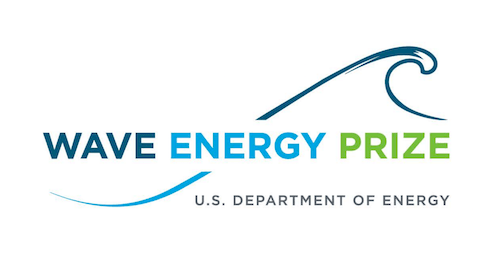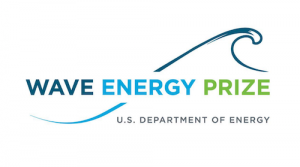
Testing Underway for Wave Energy Devices, National $2.25 Million U.S. Department of Energy Wave Energy Prize
Media Release
December 16, 2015
Contact: Meghan Collins, 207.852.8414
UMaine Composites Center Testing Underway for Wave Energy Devices, National $2.25 Million U.S. Department of Energy Wave Energy Prize
ORONO, ME – The Harold Alfond W2 Ocean Engineering Lab at the University of Maine (UMaine) Advanced Structures and Composites Center is one of five U.S. facilities competitively-selected to conduct 1:50 scale-testing as part of the U.S. Department of Energy (DOE) Wave Energy Prize this December.
The Wave Energy Prize is a 20-month design-build-test prize competition that seeks to drive game-changing innovations in wave energy devices through a rigorous testing program.
UMaine will be subjecting the wave energy devices to scale wave conditions in order to generate performance data that will allow a panel of judges selected by the DOE to evaluate the teams.
UMaine will be testing three wave energy devices as part of this program. Led by Dr. Krish Thiagarajan, Correll Chair in Energy and the Principal Investigator of the project, the project is a unique opportunity for supporting ground-breaking research and development in wave energy systems.
The DOE’s Wave Energy Prize winning team will receive a $1.5 million award, 2nd place will receive $500,000, and 3rd place will receive $250,000.
“We are extremely pleased to have been chosen, after a national competition, as one of five U.S. facilities to conduct testing for this National Wave Energy Prize,” said Dr. Habib Dagher, director of the UMaine Advanced Structures and Composites Center. “Helping identify the best ideas in the U.S. to convert wave energy into electricity is yet another way that UMaine participates in developing clean, low-cost, domestic renewable energy.”

RTI Wave Power of York, ME, led by John W. Rohrer, started testing their sixth generation “RTI F2 QD,” a 1:50 scale wave energy converter (WEC) on December 15, 2015. RTI has developed and tested advanced wave energy technologies in wave tanks for the past seven years, and holds six U. S. and international wave energy patents. RTI also has an additional six patents pending. RTI’s technical philosophy states that in order to produce a WEC that’s economically viable, it has to intercept a maximum amount of wave front while utilizing the smallest possible volume of surface float.
The “RTI F2 QD” is a wave terminator-type WEC that utilizes an elongated wave front parallel float and a semi-submerged twin spar vertical spar frame. At full scale, the RTI design would be 28 meters wide, weigh about 200 tons, have an installed cost of approximately $2-3 million per unit—making it competitive with solar and wind farms—and has a peak output of 1.5 MW per unit – enough to power more than 1,000 homes.
RTI will be testing their design in the Harold Alfond W2 Ocean Engineering Laboratory for the remainder of this week.

Oscilla Power of Seattle, WA conducted pretesting of their 1:50 scale Triton™ WEC at UMaine in late November. Developed over six years and protected by sixteen granted patents, Triton is a two-body, multi-mode point absorber consisting of a catenary moored surface float and a suspended asymmetric heave plate. Key elements of Triton’s value proposition include high energy capture, high survivability, low maintenance needs and simple installation, all of which will lead to a low cost of electricity. Tim Mundon, Oscilla Power’s Director of Marine Operations stated “We were extremely pleased that the tests confirmed our best-case power and damping predictions and that we were able to see a very close match to our numerical model. We are looking forward to returning to UMaine for the official WEP testing in January.”
Oscilla Power envisions a world where wave energy is competitive with other renewables in numerous high demand locations around the world and believes that the significant technological advancements incorporated into the Triton WEC will enable this vision to become a reality.

Float Inc. – Berger/ABAM of San Diego, CA, will be testing their WEC in January. The WEC developed by this team, led by Dr. Neal. A Brown and Dr. Markus Wernli, is called the “Rho-Cee,” which is an impedance-matched, optimizable, multi-band oscillating water column terminator – to be constructed in reinforced concrete. Float Inc. is a small high technology organization known for their development of the pneumatically stabilized platform concept that was considered and successfully tested for the DARPA Mobil Offshore Base concept. According to Float Inc., other vital team members are Seattle-based Glosten Associates, a naval architecture firm; and UK-based Trident Energy, builder of the linear generators that form the heart of the power take-off system that controls the WEC’s wave-matching input impedance. Berger/ABAM and Float Inc. have a working relationship that extends over nearly 20 years.
“We look forward to working with these private companies and entrepreneurs to help them test and potentially optimize their devices,” said Dr. Anthony Viselli, manager of the facility. “We will be helping these companies test the new devices, particularly determining their ability to convert wave energy to power.”
“This project is a great opportunity for UMaine to utilize the unique capabilities of our Alfond W2 Ocean Engineering Lab and to strengthen our ongoing partnerships with the U.S. Department of Energy and the ocean energy industry,” said Dr. Krish Thiagarajan, who has also conducted on-campus independent research on wave energy at the Marine Ocean and Offshore Research (MOOR) 8-meter long wave flume.
The Harold Alfond W2 Ocean Engineering Lab at the University of Maine Advanced Structures and Composites Center is a unique facility equipped with a high-performance rotating wind machine over a multidirectional wave basin. The facility accurately simulates scaled wind and wave conditions that represent some of the worst storms possible anywhere on Earth. It is also capable of conducting towing tests and testing at variable water depths.
This world-class ocean engineering facility assists businesses in developing products for the marine economy while offering hands-on training for students. These products include improved boat and ship hulls; ocean energy devices such as wind, wave and tidal energy; aquaculture technology; oil and gas structures; waterfront infrastructure (such as bridges, piers, docks and port facilities) as well as systems to protect coastal cities from effects of erosion and extreme storms.
1:50 scale testing for the Wave Energy Prize at UMaine begins in mid-December this year and will continue through January 2016.
About the DOE Wave Energy Prize:
The Wave Energy Prize is a public prize challenge sponsored by the U.S. Department of Energy (DOE)‘s Water Power Program. The prize is designed to increase the diversity of organizations involved in WEC technology development, while motivating and inspiring existing stakeholders. DOE envisions this competition will achieve game-changing performance enhancements to WEC devices, establishing a pathway to sweeping cost reductions on a commercial scale.
The wave energy industry is young and is experiencing many new innovations as evidenced by a sustained growth in patent activity. While the private industry is developing these early-concept WEC devices through design and benchtop prototype testing, funding is hard to secure for performance testing and evaluation of WEC devices in wave tanks at a meaningful scale. This is a problem for the industry since scaled WEC prototype tank testing, validation, and evaluation are key steps in the advancement of WEC technologies through the technical readiness levels in order to reach commercialization.
Learn more about the DOE Wave Energy Prize at: waveenergyprize.org.
